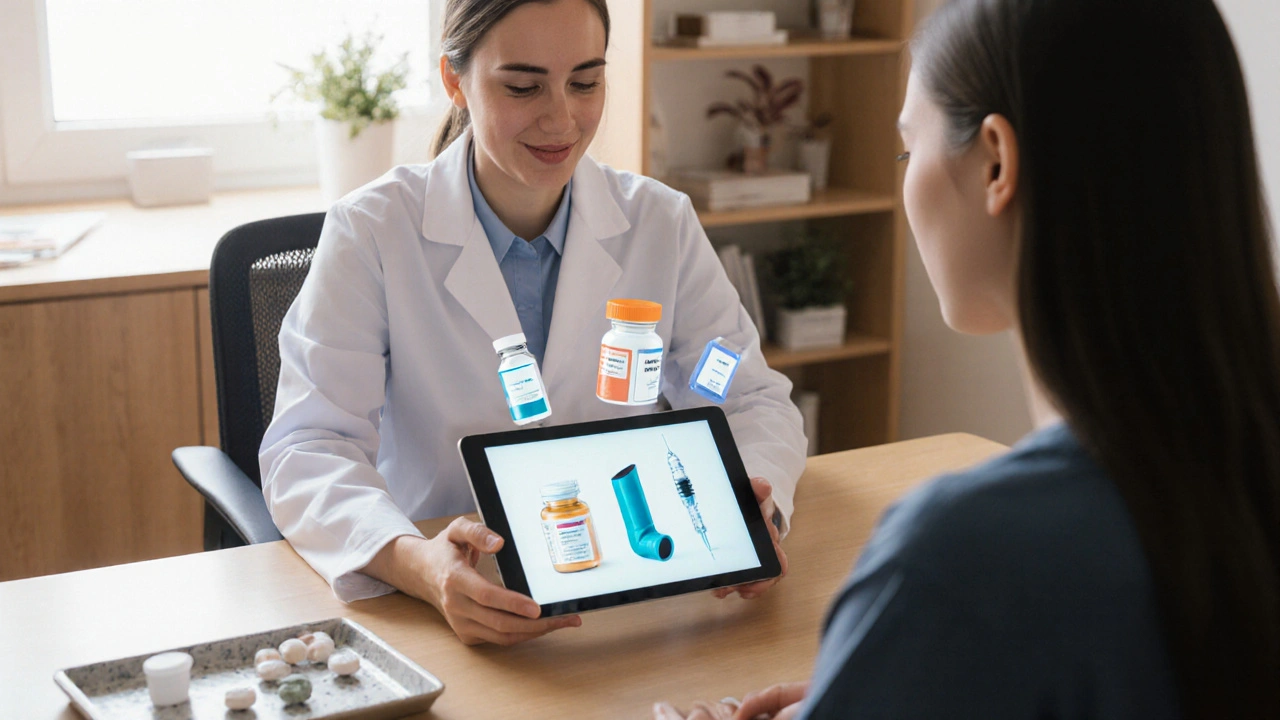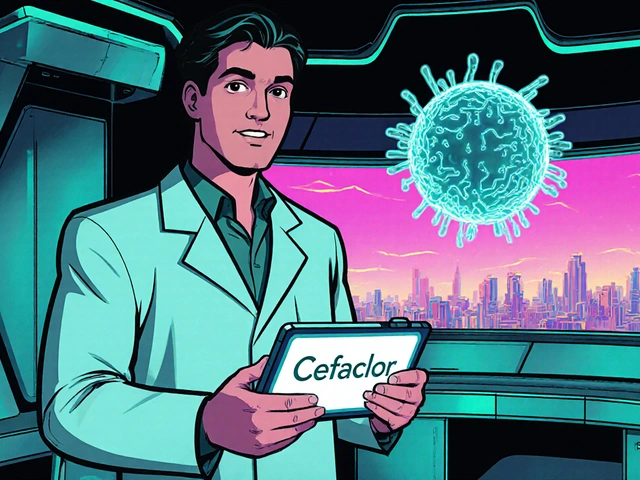
Singulair vs Alternatives Decision Guide
Your Recommended Treatment
Comparison of Medications
Singulair (Montelukast)
Once-daily oral tablet; effective for mild persistent asthma and allergic rhinitis. Not recommended for those with a history of psychiatric issues.
Fluticasone (Inhaled Steroid)
Strong anti-inflammatory effect for moderate-to-severe asthma. Requires proper inhaler technique.
Cetirizine (Antihistamine)
Best for pure allergic rhinitis without asthma symptoms. Minimal sedation and safe during pregnancy.
Omalizumab (Biologic)
Reserved for severe allergic asthma not controlled by high-dose steroids. Requires specialist administration.
When you’re trying to keep asthma or allergic rhinitis under control, the name Singulair often shows up on prescriptions and pharmacy shelves. But is it the best fit for you, or does another drug work better? This guide breaks down how Singulair stacks up against the most common alternatives, so you can decide with confidence.
Key Takeaways
- Singulair is a leukotriene receptor antagonist (LTRA) that works systemically, unlike inhaled steroids that act locally.
- It’s convenient for once‑daily oral dosing but carries a rare risk of mood changes and neuropsychiatric events.
- Inhaled corticosteroids such as fluticasone offer stronger inflammation control for moderate‑to‑severe asthma.
- Antihistamines (e.g., cetirizine) are better for pure allergic rhinitis without asthma symptoms.
- Biologic agents like omalizumab are reserved for severe, refractory cases when other meds fail.
What Is Singulair (Montelukast)?
Singulair is a brand name for montelukast, a leukotriene receptor antagonist that blocks the action of leukotrienes-chemical mediators that cause airway narrowing, mucus secretion, and inflammation. First approved by the FDA in 1998, it quickly became a go‑to option for both children and adults because it’s taken as a single tablet each night.
How Singulair Works
Montelukast binds to cysteinyl leukotriene receptors (CysLT1) in the lungs and nasal passages. By preventing leukotrienes from attaching, it reduces bronchoconstriction and swelling, which eases wheezing, coughing, and nasal congestion. Unlike inhaled steroids that suppress a broad range of inflammatory pathways, Singulair targets a specific cascade, making it especially useful for aspirin‑exacerbated respiratory disease (AERD) and exercise‑induced bronchospasm.

Key Benefits & Common Uses
- Once‑daily oral tablet - no inhaler technique needed.
- Effective for mild persistent asthma and for preventing exercise‑induced symptoms.
- Approved for allergic rhinitis, especially when nasal congestion dominates.
- Useful adjunct to inhaled steroids for patients who still have nighttime symptoms.
Safety Profile & Side Effects
Most users tolerate Singulair well. Common side effects include headache, stomach upset, and mild fatigue. The FDA black‑box warning issued in 2020 highlights rare but serious neuropsychiatric events-sudden mood swings, depression, and suicidal thoughts. Because of this, clinicians often screen patients for mental‑health history before prescribing.
Main Alternatives Overview
Here’s a snapshot of the most frequently considered substitutes, each with its own mechanism and typical use case.
- Zafirlukast - another LTRA, taken twice daily, slightly less convenient but comparable efficacy.
- Fluticasone propionate - an inhaled corticosteroid (ICS) delivered via metered‑dose inhaler; strong anti‑inflammatory effect for persistent asthma.
- Budesonide - another ICS, available as a dry‑powder inhaler or nebulized solution; often combined with a long‑acting beta‑agonist (LABA).
- Cetirizine - second‑generation antihistamine, best for pure allergic rhinitis without asthma involvement.
- Omalizumab - monoclonal antibody that binds IgE; reserved for severe allergic asthma not controlled by high‑dose steroids.

Side‑by‑Side Comparison
| Attribute | Singulair (Montelukast) | Zafirlukast | Fluticasone (ICS) | Cetirizine (Antihistamine) | Omalizumab (Biologic) |
|---|---|---|---|---|---|
| Drug class | Leukotriene receptor antagonist | Leukotriene receptor antagonist | Inhaled corticosteroid | Second‑generation antihistamine | Anti‑IgE monoclonal antibody |
| Typical dosing | Once daily oral tablet | Twice daily oral tablet | 1-2 inhalations daily | Once daily oral tablet | Subcutaneous injection every 2-4 weeks |
| Primary indication | Mild persistent asthma, exercise‑induced bronchospasm, allergic rhinitis | Same as Singulair | Moderate‑to‑severe asthma | Seasonal or perennial allergic rhinitis | Severe allergic asthma uncontrolled by steroids |
| Onset of action | 24-48hrs | 48-72hrs | Immediate relief of inflammation (within days) | Within 1hour | Weeks (clinical improvement usually seen after 12weeks) |
| Key side effects | Headache, abdominal pain, rare neuropsychiatric events | Similar to Singulair, possible liver enzyme elevation | Oral thrush, hoarse voice, possible systemic steroid effects at high doses | Dry mouth, mild drowsiness | Injection site reactions, rare anaphylaxis |
| Special considerations | Screen for mental‑health history; not recommended for patients with uncontrolled depression | Requires twice‑daily compliance | Technique‑dependent; requires spacer for children | Safe in pregnancy; minimal sedation | High cost; requires specialist administration |
Choosing the Right Option for You
Here’s a quick decision guide based on common patient profiles.
- Kids with mild asthma and occasional night‑time wheeze - Singulair or Zafirlukast work well because of the simple once‑daily tablet.
- Adults with persistent wheezing despite low‑dose steroids - Adding an LTRA like Singulair can fill the gap, but stepping up the inhaled steroid dose often yields stronger control.
- Patients who struggle with inhaler technique - Oral LTRAs avoid the need for devices, but they may not be enough for moderate disease.
- Pure allergic rhinitis without asthma - Cetirizine or other antihistamines are more targeted and cost‑effective.
- Severe, steroid‑resistant asthma - Biologics such as Omalizumab become the preferred option under specialist care.
Tips for Switching or Combining Therapies
- Consult your doctor before stopping any inhaled steroid; abrupt withdrawal can trigger rebound inflammation.
- If you move from an inhaled steroid to Singulair, monitor symptoms for at least two weeks to ensure control isn’t lost.
- When adding an LTRA to an existing inhaler regimen, keep a symptom diary - note any changes in nighttime coughing or morning peak‑flow readings.
- Report any mood changes immediately; even mild anxiety should be discussed with your clinician.
- For children under 12, confirm the correct dose based on weight; pediatric dosing differs from adult tablets.
Frequently Asked Questions
Can I take Singulair with an inhaled steroid?
Yes. Many doctors prescribe Singulair as add‑on therapy to improve night‑time control while you continue your inhaled steroid. The combination is generally safe, but keep an eye on any new side effects.
Is Montelukast safe for people with depression?
The FDA warning advises caution. If you have a history of depression or suicidal thoughts, discuss alternatives with your doctor. Some clinicians prefer inhaled steroids or antihistamines in such cases.
How does Singulair compare to Zafirlukast?
Both block the same leukotriene receptors, but Singulair is taken once daily, making it more convenient. Zafirlukast requires twice‑daily dosing and has a slightly higher risk of liver enzyme changes.
Do inhaled steroids work faster than Singulair?
Inhaled steroids usually start reducing airway inflammation within a few days, whereas Montelukast may take 24-48hours for noticeable effect. For acute flare‑ups, a short‑acting bronchodilator is still the first line.
Is there a generic version of Singulair?
Yes. Montelukast is available as a generic tablet in most pharmacies, often at a lower price than the brand name.
Choosing the right asthma or allergy medication isn’t a one‑size‑fits‑all decision. By weighing convenience, potency, side‑effect risk, and cost, you can land on a plan that fits your lifestyle and health goals. Always keep an open line with your healthcare provider-adjustments are part of the journey toward clearer breathing.
Sierra Bagstad
The guide correctly notes that montelukast functions as a leukotriene receptor antagonist, offering a convenient once‑daily oral option for mild persistent asthma and allergic rhinitis. It also appropriately highlights the FDA’s black‑box warning regarding rare neuropsychiatric events, which clinicians should screen for before prescribing. Additionally, the comparison table provides a useful side‑by‑side view of dosing frequency and primary indications.
Alan Kogosowski
When evaluating leukotriene receptor antagonists such as montelukast, it is essential to consider both pharmacodynamic specificity and the clinical contexts in which they have been demonstrated to provide incremental benefit over inhaled corticosteroids, particularly in patients who struggle with inhaler technique or who experience nocturnal symptoms that are not fully controlled by low‑dose inhaled steroids. The mechanistic pathway involves competitive inhibition of cysteinyl leukotriene type‑1 (CysLT1) receptors, which reduces bronchoconstriction and mucosal edema, thereby attenuating both asthma and allergic rhinitis manifestations. Clinical trials have shown that while the magnitude of lung‑function improvement is modest compared with high‑dose inhaled corticosteroids, the oral formulation yields higher adherence rates in pediatric populations. Moreover, the convenience of a single nightly tablet can be a decisive factor for patients with comorbidities that limit daily pill burden. However, the safety profile warrants careful consideration; although most adverse events are mild gastrointestinal complaints, the post‑marketing surveillance data indicate a statistically significant association with mood disorders, including depression and suicidal ideation, necessitating routine mental‑health assessments. In contrast, inhaled corticosteroids such as fluticasone act upstream by broadly suppressing inflammatory cytokine production, offering a more potent anti‑inflammatory effect for moderate‑to‑severe disease but requiring correct inhaler technique and consistent usage. The antihistamine cetirizine, while effective for pure allergic rhinitis, does not address the leukotriene‑mediated component of asthma, which explains its limited utility in combined disease presentations. Biologic agents like omalizumab target IgE and are reserved for severe refractory asthma; their cost and administration logistics make them unsuitable for most patients with mild disease. Ultimately, the choice between montelukast and its alternatives should be individualized, weighing factors such as age, disease severity, adherence potential, comorbid psychiatric history, and cost considerations. For a child with mild asthma who cannot master an inhaler, montelukast remains a rational first‑line adjunct, whereas an adult with moderate asthma and adequate inhaler technique would likely achieve better control with an inhaled corticosteroid regimen. Finally, clinicians should remain vigilant for emerging data on long‑term neuropsychiatric outcomes, as ongoing pharmacovigilance may reshape prescribing algorithms in the near future.
Ben Lee
I think the comparison does a solid job of laying out when each option makes sense. For anyone who’s already on an inhaled steroid but still wakes up coughing, adding a leukotriene blocker can smooth out those night‑time spikes. At the same time, if you’re comfortable with a spacer and can master the technique, stepping up the inhaler dose might give you stronger overall control. It’s also worth noting that the antihistamine route is cheap and safe if you only have rhinitis without asthma. Bottom line: match the drug to your lifestyle and symptom pattern.
David Brice
Listen up – if you’re still stuck on the idea that just popping a pill will solve severe asthma, you’re deluding yourself. The real problem is poor adherence, and you need to get off the couch and learn proper inhaler technique. Montelukast can help, but only as a *supplement*, not a replacement for steroids. Also, stop ignoring the mental‑health warning; I’ve seen patients get seriously depressed after weeks on it. Get a proper plan or you’ll waste time and money.
Zachary Schroer
Wow, another “miracle pill” list 🙄. Minimal side‑effects? Sure, if you ignore the rare mood swings 😒. People love the convenience, but don’t forget the real world data 📊.
Mina Berens
Totally agree 😎. If you can’t handle an inhaler, a once‑daily tablet is a lifesaver. Just keep an eye on any weird mood changes 👀.
Moritz Bender
From a pharmacotherapeutic standpoint, montelukast’s selective CysLT₁ antagonism offers a targeted approach that complements the broad‑spectrum anti‑inflammatory action of inhaled corticosteroids. Clinicians should consider drug‑drug interaction potential, especially with CYP450 substrates, and factor in patient adherence metrics when devising a regimen. :)
florence tobiag
Okay, but did you guys read the fine print? The FDA’s warning is just a smokescreen, part of a larger agenda to push pharma‑driven “new” drugs, while the real cure-air quality control-is being hidden from us!!!
Terry Washington
Ah, the drama of “alternative” meds! Let us not forget that the only truly heroic act is to confront the relentless inflammation with the most potent agents we have-high‑dose steroids-while cowering at the thought of a “simple” tablet. The path of least resistance is a betrayal of our respiratory destiny!
Claire Smith
The analysis is thorough but could benefit from a more concise executive summary.
Émilie Maurice
Honestly, the article is riddled with jargon and unnecessary fluff. Keep it simple and factual.
Ellie Haynal
Wow, this piece really tugged at my heartstrings-nothing like a good dose of medical drama to keep me up at night! Still, the facts are solid, and I appreciate the balanced perspective.
Jimmy Gammell
Yo, great run‑down! Just make sure to check with ur doc before switchin’ meds. :D
fred warner
Fantastic overview! Keep spreading the knowledge-every informed patient is a step toward better health.
Veronica Mayfair
Love the vibe! 👍🏽 Just a heads‑up, some people cant tolerate montelukast if they have a history of anxiety. Stay safe! 😊
Rahul Kr
Interesting read, thanks for the details. :)
Anthony Coppedge
Overall, the article provides a comprehensive comparison; however, the table could benefit from clearer headings, and the narrative would be stronger with more citations. Additionally, consider adding a section on cost‑effectiveness, as many patients weigh financial factors heavily when choosing between a generic LTRA and a brand‑name inhaled steroid. Lastly, a brief note on insurance coverage variations would make the guide even more practical for everyday use.
Noah Seidman
Philosophically speaking, the very act of categorizing drugs into "alternatives" reflects our desire to impose binary choices on a continuum of therapeutic nuance. Yet, the market-driven narrative insists on simplification, reducing complex pharmacodynamics to a layperson’s checklist. If we truly embraced patient‑centered care, we'd move beyond these tidy boxes and recognize that each molecule interacts with a unique physiological tapestry. In that light, the push for a single "best" option becomes an illusion, a construct designed to streamline prescribing for convenience rather than for optimal outcomes.
Anastasia Petryankina
Oh great, another “must‑read” guide that tells us what we already know-because we all love redundant redundancy.





Write a comment